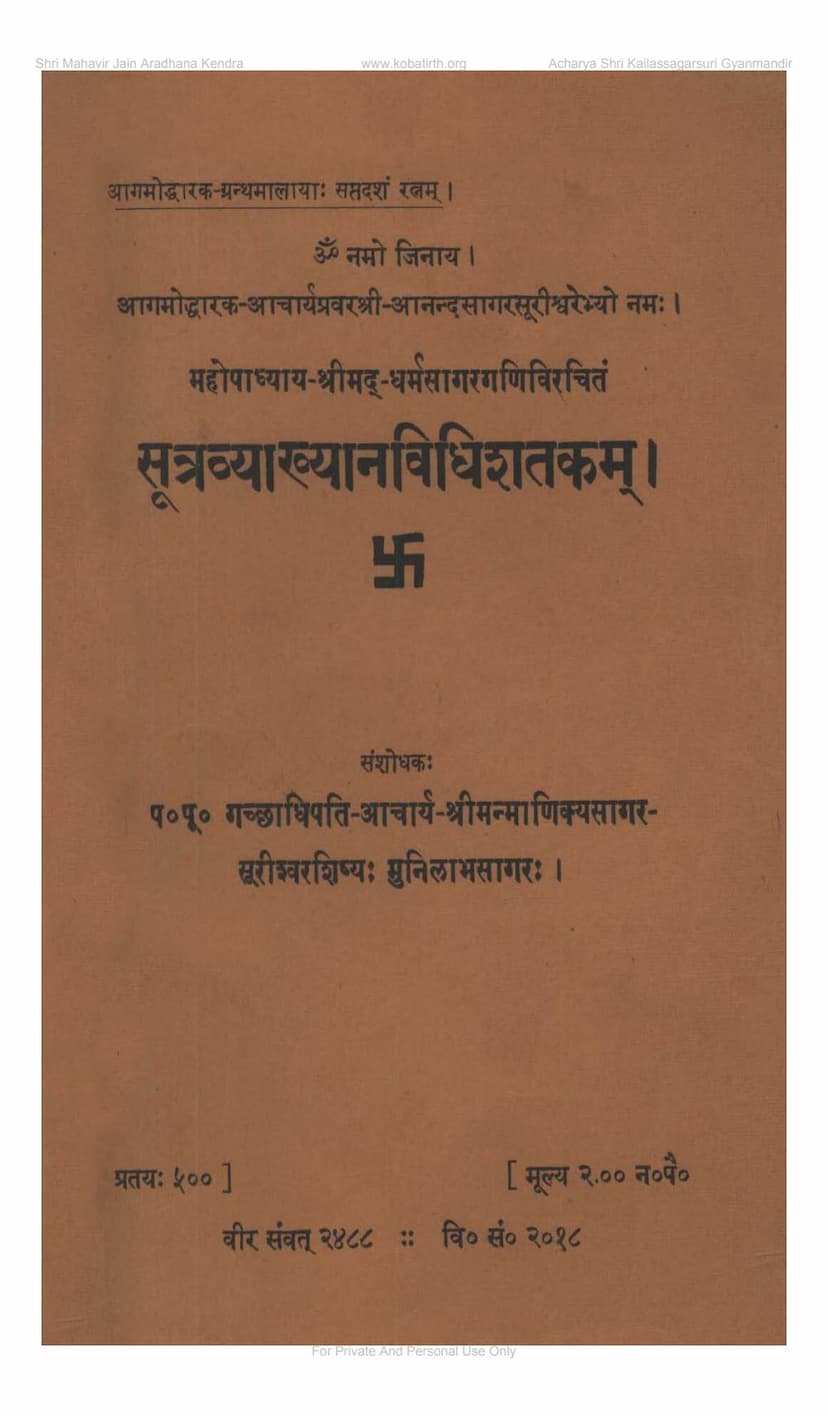Sutra Vyakhayan Vidhi Shatakam
Added to library: September 2, 2025

Summary
Here's a comprehensive summary of the Jain text "Sutra Vyakhayan Vidhi Shatakam" based on the provided pages:
Book Title: Sutra Vyakhayan Vidhi Shatakam (A Century of Methods for Explaining Sutras) Author: Mahopadhyay Shrimad Dharmsagar Gani Researched/Edited by: Muni Labhsagar (disciple of Acharya Shriman Manikysagar Surishwar) Publisher: Mithabhai Kalyanchand Pedhi, Kapadvanj
Overview:
This text, "Sutra Vyakhayan Vidhi Shatakam," authored by Mahopadhyay Shrimad Dharmsagar Gani, is a significant work that delves into the intricacies of explaining Jain scriptures (sutras). It aims to guide scholars and students in understanding the proper methodologies for interpreting and presenting the profound teachings of Jainism. The book is presented as the seventeenth gem in the "Agamoddharak Granthamala," indicating its importance in the preservation and dissemination of Jain scriptures.
Key Themes and Concepts Discussed:
The book meticulously explores various aspects of explaining Jain sutras, including:
- The Nature of Sutras: It defines what constitutes a true sutra, emphasizing qualities like brevity (alpagrath), profound meaning (mahattva), absence of thirty-two specific defects (dwatrimshat dosavirahitam), and being adorned with eight essential virtues (ashtau gunopetam). These virtues include being faultless, meaningful, reasoned, adorned, relevant, easily understandable, concise, and sweet-sounding.
- The Process of Anuyog (Exposition/Explanation): The text elaborates on the three types of anuyog:
- Sutrarth (Meaning of the Sutra): The primary exposition focusing on the literal meaning of the sutra.
- Niyukti Mishrak (Intermixed with Niyukti): An exposition that integrates the meaning with the explanations found in Niyuktis (commentaries or elucidations).
- Niravshesh (Exhaustive/Comprehensive): The most detailed exposition that covers all related topics, including those arising from context or association (prasang-anuprasang).
- The Importance of Gurus and Disciples: It stresses the necessity of qualified gurus and diligent disciples for the proper transmission of knowledge. Gurus must possess unbroken lineage and mastery of the sutras, while disciples must be attentive and capable of grasping the teachings. The text highlights the responsibility of gurus and the potential consequences of teaching unqualified students.
- Types of Niyuktis and Their Function: It discusses the three types of Niyuktis (Nikshepa, Ughghata, and Sutra-Sphashita) and their significance in understanding sutras. Specifically, the Upo'dhata Niyukti (introductory Niyukti) is highlighted as crucial for all sutras, as it explains the twenty-six 'Dwaras' (topics or gatekeepers of understanding).
- The Concept of Tirtha (Sacred Order/Teaching): A significant portion of the book is dedicated to defining and distinguishing true Tirtha (the holy congregation of monks, nuns, laymen, and laywomen following the true path) from Atirtha (untrue paths or deviations). The criteria for identifying a true Tirtha are linked to adherence to the sutras, the teachings of the Tirthankaras, and the principles of right faith (samaktva).
- Critique of Non-Jain Paths and Deviations: The text critically examines various paths and sects that deviate from the true Jain teachings. It discusses Unmarga (wrong paths) in both worldly (laukika) and transcendental (loko'ttara) contexts. It specifically addresses the flaws and erroneous beliefs of various groups, including Digambaras, Paurinimikakas, Laumpakas, and others, exposing their deviations from the original Jain doctrine and their claims of having their own Tirthankaras or spiritual leaders.
- The Nature of Mithyatva (False Belief) and Samyaktva (Right Faith): The book delves into the different classifications of Mithyatva, including the distinction between Agaadha (deep) and Anaagaadha (shallow) Mithyatva, and further breaks them down into categories like Abhigrahika (dogmatic), Anabhigrahika (non-dogmatic), Saamsayika (doubtful), and Anabhoga (unmindful). It explains how these false beliefs arise and their impact on spiritual progress. It contrasts this with the nature of Samyaktva, which is achieved through understanding and faith in the true principles of Jainism, supported by Niyuktis and other authentic scriptures.
- The Role of the Mahanishith Sutra: The text emphasizes the authority of the Mahanishith Sutra as a benchmark for identifying a true Tirtha. It discusses the meticulous preservation and interpretation of this significant scripture by past Acharyas like Haribhadra Suri.
- The Importance of Actions Aligned with Right Faith: The book stresses that mere adherence to rituals or practices without the foundation of right faith (Samyaktva) is insufficient for spiritual progress. It clarifies that actions performed with the correct understanding and faith, even if outwardly similar to those of others, lead to liberation.
- The Nuances of Language and Interpretation: The text highlights the importance of precise language and understanding the underlying intent (bhava) behind words. It discusses how even seemingly similar phrases or actions can have different meanings and consequences depending on the underlying faith and intention.
- The Authority of Agamas and Guruparampara: A consistent theme is the reliance on the authentic Jain Agamas (scriptures) and the unbroken lineage of spiritual teachers (Guruparampara) for correct interpretation. It refutes claims that deviate from these authoritative sources.
Author and Context:
Mahopadhyay Shrimad Dharmsagar Gani, a learned scholar, authored this work. The book was researched and published by Muni Labhsagar under the guidance of Acharya Shriman Manikysagar Surishwar, highlighting a commitment to preserving and promoting Jain scriptures. The publication dates back to Vikram Samvat 2018 (1961 CE).
Overall Significance:
"Sutra Vyakhayan Vidhi Shatakam" serves as a foundational text for understanding the methods of scriptural exposition in Jainism. It is a rigorous exploration of doctrinal nuances, emphasizing accuracy, adherence to tradition, and the critical evaluation of different viewpoints. The book's detailed analysis of various philosophical concepts and its refutation of heterodox interpretations make it a valuable resource for scholars and practitioners seeking a deeper understanding of Jain philosophy and its exegetical traditions.